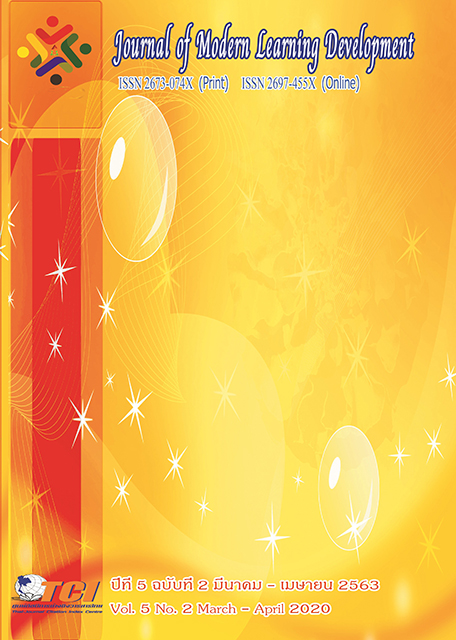A Confirmatory Model for Strategic Management of North Eastern Rajabhat University Cluster
Main Article Content
Abstract
The research aimed 1) to investigate the major components and sub-components of strategic management of the northeastern Rajabhat University cluster, 2) to examine a model for assessing the major components and sub-components of strategic management of the northeastern Rajabhat universities and 3) to confirm the model for assessing the major components and sub-components of strategic management of the northeastern Rajabhat universities. Mixed methods research was employed for the study. The sample subjects were two hundred and ninety fiveexecutives of the northeastern Rajabhat universities consisting of low-level, middle-level and high level executives. They were selected by stratified random sampling and simple random sampling. The data was collected by questionnaires and descriptive analysis was employed for the research. The statistics used were frequency, percentage, mean, standard deviation and descriptive analysis.
The researchfindings were as follows:
1.The research findings showed that the three major components of strategic management of the northeastern Rajabhat University clusterconsisted of organizational culture, strategic leadership and organizational innovation. The ten sub-components of strategic management of the universities were integration, achievement motivation, human resource management, strategic thinking skills, problem resolution and decision, communication and negotiation, building motivation and drives, systematical management, creative thinking and marketing. There were fifty nine indicators for both the major components and sub-components.
2.The findings indicated that the model of strategic management of the northeastern Rajabhat universitiesregarding the confirmatory analysis was consistent with the empirical data. The value of Chi - square was 30.415,df = 27,P = 0.296,CFI = 0.997, NFI = 0.973, RMR = 0.022, and RMSEA = 0.021. The findings revealed that all of the components on strategic management the northeastern Rajabhat universities were consistent with the empirical data.
3.The findings indicated that the model regarding the confirmatory assessment of the seventeen experts and the statistical analysiswas consistent positively with the empirical data. The average opinion of the exterts towardthe appropriateness of the model. The two highest rated items of the model were utility standards (x̄ = 4.58) andfeasibility standards (x̄ = 4.52), and thetwo high rated items of the modelwere accuracy standards (x̄ = 4.41), and propriety standards (x̄ = 4.29) respectively.
Article Details
References
กฤษณา สุขบุญญสถิต. (2554). การพัฒนาดัชนีชี้วัดความสำเร็จของการบริหารจัดการสถาบันอุดมศึกษาของรัฐ. วิทยานิพนธ์ศิลปศาสตรดุษฎีบัณฑิต สาขาวิชาพัฒนศาสตร์. บัณฑิตวิทยาลัย: มหาวิทยาลัยขอนแก่น.
กระทรวงศึกษาธิการ. (2551). กรอบแผนอุดมศึกษาระยะยาว 15 ปี ฉบับที่ 2 (พ.ศ.2551-2565). กรุงเทพมหานคร: กระทรวงศึกษาธิการ.
ชัยยนต์ เพาพาน. (2555). แนวโน้มยุทธศาสตร์การพัฒนามหาวิทยาลัยราชภัฏรุ่นใหม่ในทศวรรษหน้า. วิทยานิพนธ์ปรัชญาดุษฎีบัณฑิต สาขาบริหารการศึกษา. บัณฑิตวิทยาลัย: มหาวิทยาลัยขอนแก่น.
ทศพร ศิริสัมพันธ์. (2543). การตรวจราชการของผู้ตรวจราชการสำนักนายกรัฐมนตรี: กลไกสำคัญในการบริหารราชการแผ่นดิน. เอกสารวิจัย (รป.ม.). กรุงเทพมหานคร: จุฬาลงกรณ์มหาวิทยาลัย.
ทิพาวดี เมฆสวรรค์. (2545). กล้าคิด กล้าทำ กล้านำ กล้าเปลี่ยน. (พิมพ์ครั้งที่ 2). กรุงเทพมหานคร: เอ็กซเปอร์เน็ท.
บุญทัน ดอกไธสง. (2555). รัฐประศาสนศาสตร์สร้างสรรค์. กรุงเทพมหานคร: ปัญญาชน.
มหาวิทยาลัยราชภัฏกลุ่มภาคตะวันออกเฉียงเหนือ. (2559). การประชุมอธิการบดีราชภัฏ ครั้งที่ 2/2559. สกลนคร: มหาวิทยาลัยราชภัฏกลุ่มภาคตะวันออกเฉียงเหนือ
วุฒิพงษ์ ภักดีเหลา. (2554). การศึกษาคุณลักษณะขององค์การนวัตกรรม: กรณีศึกษาองค์การที่ได้รับรางวัลด้านนวัตกรรม. วิทยานิพนธ์วิทยาศาสตรมหาบัณฑิต สาขาการพัฒนาทรัพยากรมนุษย์และองค์กร. บัณฑิตวิทยาลัย: คณะพัฒนาทรัพยากรมนุษย์ สถาบันบัณฑิตพัฒนบริหารศาสตร์.
ศิริภัทร ดุษฎีวิวัฒน์. (2555). ภาวะผู้นำที่มีผลต่อขวัญและกำลังใจในการปฏิบัติงานของพนักงานธนาคารออมสิน สำนักงานใหญ่. การค้นคว้าอิสระปริญญาบริหารธุรกิจมหาบัณฑิต. บัณฑิตวิทยาลัย: มหาวิทยาลัยเทคโนโลยีราชมงคลธัญบุรี.
สมชาย ภคภาสน์วิวัฒน์. (2551). การบริหารเชิงกลยุทธ์. (พิมพ์ครั้งที่ 18). กรุงเทพมหานคร:อมรินทร์.
สมนึก เอื้อจิระพงษ์พันธ์ และคณะ (2553). นวัตกรรม: ความหมาย ประเภท และความสำคัญต่อการเป็นผู้ประกอบการ. วารสารบริหารธุรกิจ, 33 (128), 49-65.
สำนักงานคณะกรรมการการอุดมศึกษา. (2556). แผนพัฒนาการศึกษาระดับอุดมศึกษา ฉบับที่ 11 (พ.ศ. 2555-2559). กรุงเทพมหานคร: โรงพิมพ์แห่งจุฬาลงกรณ์มหาวิทยาลัย.
สำนักงานคณะกรรมการอุดมศึกษา. (2558). คู่มือปฏิบัติงานการวางแผนอัตรากำลังทรัพยากรบุคคลอุดมศึกษา. กรุงเทพมหานคร: กลุ่มมาตรฐานการบริหารงานบุคคล สำนักงานส่งเสริมและพัฒนาสมรรถนะบุคลากร.
เสน่ห์ จุ้ยโต. (2558). การบริหารนวัตกรรมแนวใหม่. นนทบุรี: โครงการส่งเสริมการแต่งตำรา มหาวิทยาลัยสุโขทัยธรรมาธิราช.
Adair, John Eric. (2010). Strategic leadership: How to think and plan strategically and provide direction. London: KoganPage.
DuBrin, Andrew J. (2010). Principles of leadership. (6 th ed). Canada: South-Western Cengage Learning International Student Edition.
Ekvall, Goran. (2002). Organizational conditions and levels of creativity In Managing innovation and change. (2nd ed). London: Thousand Oaks Calif: Open University Business School in association with SAGE.
Greenberg, Jerald. (2005). Managing Behavior in Organizations. (4th ed). New Jersey: Pearson Prentice Hall.
Guan, J., & Ma, N. (2003). Innovative capability and export performance of Chinese firms. Tec novation, 23(9), 737-747.
Hair, J.F. et al. (2006). Multivariate Data Analysis. New Jersey: Pearson Prentice Hall.
L. Yuvares, L. (2016). Corrupt problems in the Thai education system. APHEIT JOURNAL. 5(1), 66-76.
Potter-Efron, Ronald T. (2005). Handbook of anger management: group, individual, couple, and family approaches.Binghamton. N.Y. :Haworth Clinical Practice.


